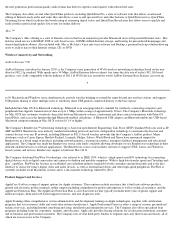Apple 2003 Annual Report Download - page 20
Download and view the complete annual report
Please find page 20 of the 2003 Apple annual report below. You can navigate through the pages in the report by either clicking on the pages listed below, or by using the keyword search tool below to find specific information within the annual report.
annually, or earlier if indicators of potential impairment exist. The review of goodwill for potential impairment is highly subjective and requires
that: (1) goodwill be allocated to various reporting units of the Company's business to which it relates; (2) the Company estimate the fair value
of those reporting units to which the goodwill relates; and (3) the Company determine the book value of those reporting units. If the estimated
fair value of reporting units with allocated goodwill is determined to be less than their book value, the Company is required to estimate the fair
value of all identifiable assets and liabilities of those reporting units in a manner similar to a purchase price allocation for an acquired business.
This requires independent valuation of certain internally developed and unrecognized assets including in-
process research and development and
developed technology. Once this process is complete, the amount of goodwill impairment, if any, can be determined.
Based on the Company's estimates as of September 27, 2003, there was no impairment of goodwill. However, changes in various
circumstances including changes in the Company's market capitalization, changes in the Company's forecasts, and changes in the Company's
internal business structure could cause one or more of the Company's reporting units to be valued differently thereby causing an impairment of
goodwill. Additionally, in response to changes in the personal computer industry and changes in global or regional economic conditions, the
Company may strategically realign its resources and consider restructuring, disposing, or otherwise exiting businesses, which could result in an
impairment of property, plant, and equipment, identifiable intangibles, or goodwill.
Warranty Costs
The Company provides currently for the estimated cost for product warranties at the time the related revenue is recognized based on historical
experience of failure rates. Each quarter, the Company reevaluates its estimates to assess the adequacy of its recorded warranty liabilities and
adjusts the amounts
22
as necessary. If actual product failure rates or repair costs differ from estimates, revisions to the estimated warranty liability would be required
and could negatively affect the Company's results of operations.
Income Taxes
The Company records a tax provision for the anticipated tax consequences of the reported results of operations. In accordance with SFAS
No. 109,
Accounting for Income Taxes , the provision for income taxes is computed using the asset and liability method, under which deferred
tax assets and liabilities are recognized for the expected future tax consequences of temporary differences between the financial reporting and
tax bases of assets and liabilities, and for operating losses and tax credit carryforwards. Deferred tax assets and liabilities are measured using
the currently enacted tax rates that apply to taxable income in effect for the years in which those tax assets are expected to be realized or
settled. The Company records a valuation allowance to reduce deferred tax assets to the amount that is believed more likely than not to be
realized.
Management believes it is more likely than not that forecasted income, including income that may be generated as a result of certain tax
planning strategies, together with the tax effects of the deferred tax liabilities, will be sufficient to fully recover the remaining deferred tax
assets. In the event that all or part of the net deferred tax assets are determined not to be realizable in the future, an adjustment to the valuation
allowance would be charged to earnings in the period such determination is made. Similarly, if the Company subsequently realizes deferred tax
assets that were previously determined to be unrealizable, the respective valuation allowance would be reversed, resulting in a positive
adjustment to earnings in the period such determination is made. In addition, the calculation of tax liabilities involves significant judgment in
estimating the impact of uncertainties in the application of complex tax laws. Resolution of these uncertainties in a manner inconsistent with
management's expectations could have a material impact on the Company's results of operations and financial position.
23
Net Sales
Net sales and Macintosh unit sales by operating segment and net sales and unit sales by product follow (net sales in millions and Macintosh
unit sales in thousands):
2003
Change
2002
Change
2001
Net Sales by Operating Segment:
Americas net sales (a) $
3,181
2
%
$
3,131
3
%
$
3,037
Europe net sales
1,309
5
%
1,251
0
%
1,249
Japan net sales
698
(2
)%
710
0
%
713
Retail net sales
621
119
%
283
—
19
























